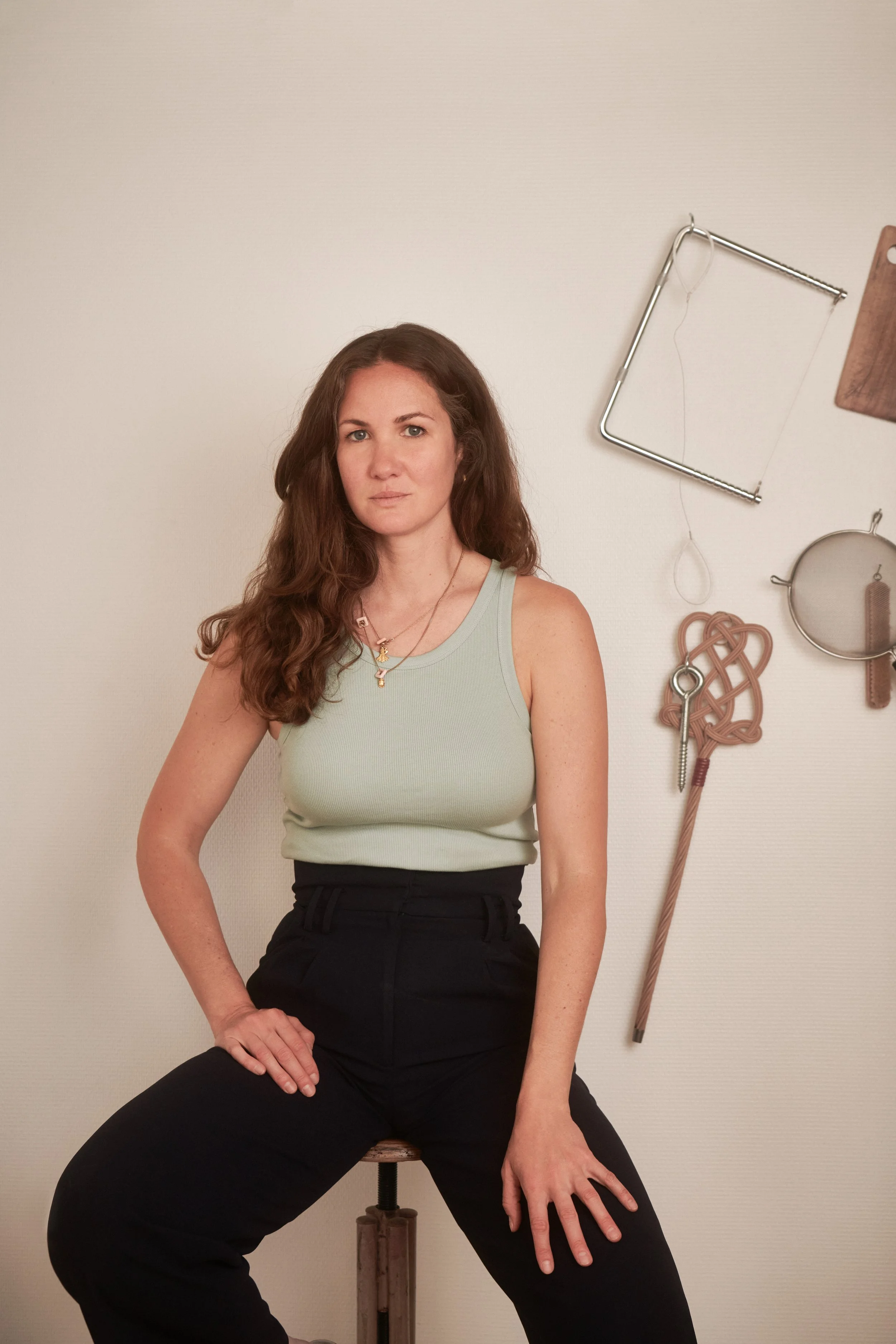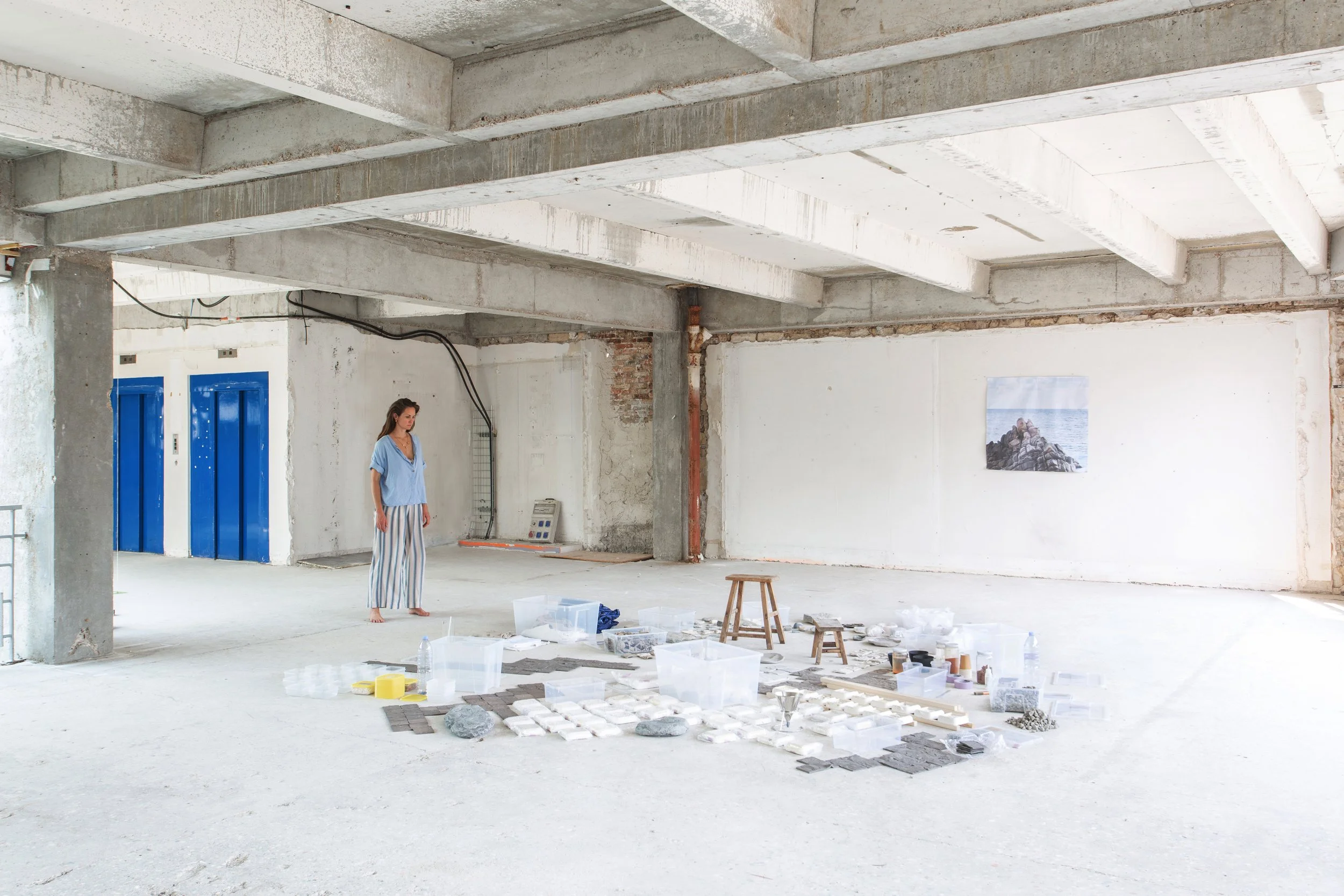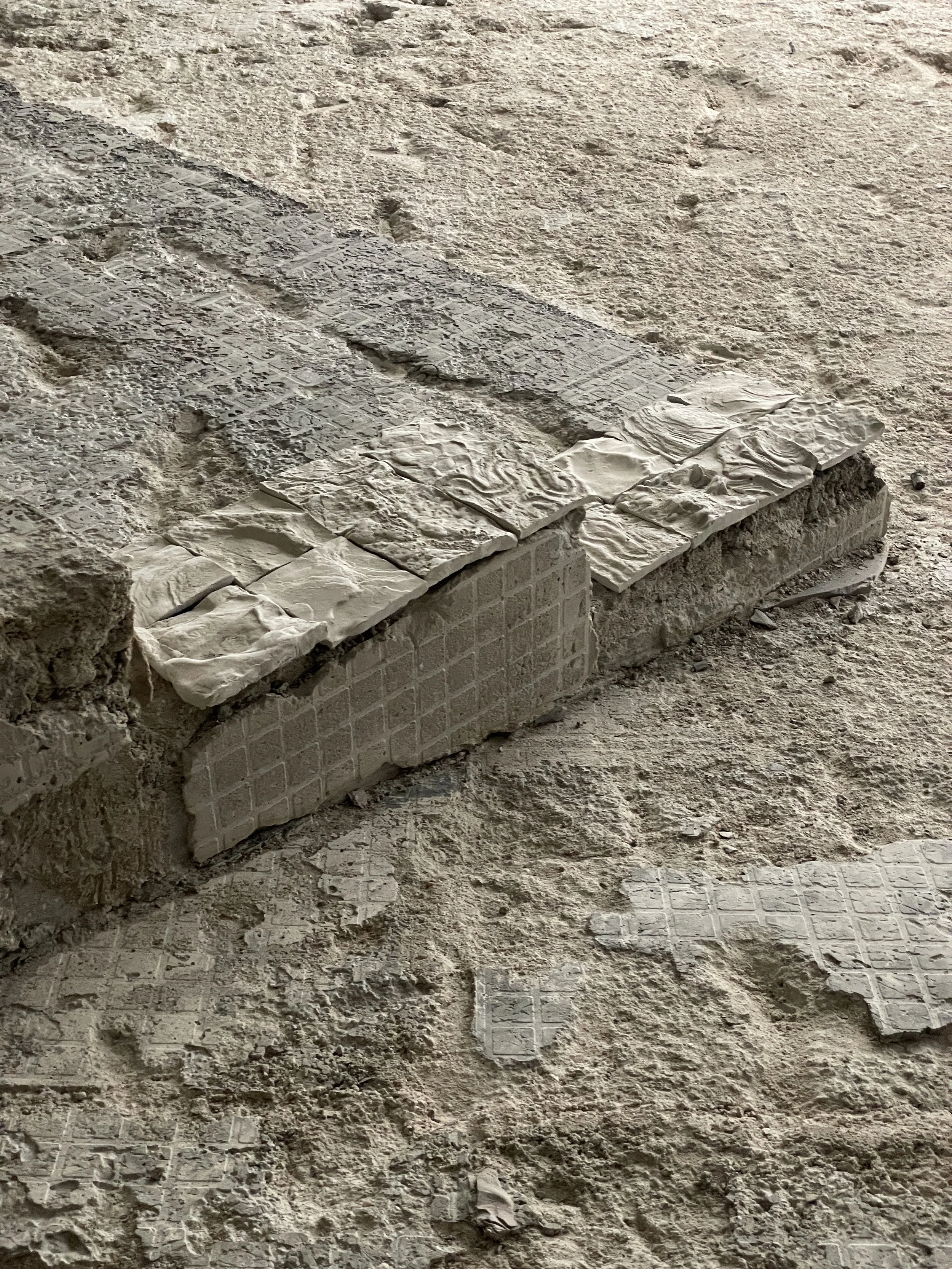Clémentine Debaere-Lewandowski
Clémentine, please introduce yourself:
My name is Clémentine Debaere-Lewandowski, I am a french architect and artist born in 1987. I live mostly in Paris, where my atelier is located, and I spend as much time as possible at my research and experimentation locations.
Photo © Léa Boeglin
I founded my interdisciplinary creative studio in 2022, which focuses on art, research, and architecture. Since February 2024, I do research on minerals as a medium of imagination and language at the Institute of Civilizations of Collège de France.
#1 Can you tell us a bit about your training? How did it influence you to find your way ?
I really believe it’s a continuous process. What we want to learn influences our path, then what we’ve learned influences the way we think and the new things we want to learn - and the cycle starts all over again.
I love to explore new fields, and for that, it’s always about observation, understanding and learning from the environment and expertise I am confronted with. I studied art in my early years and later architecture, in several places - first in Bordeaux, Florence (it) and finally Paris at Versailles.
I took part in several workshops on raw earth, straw, and natural composite materials at Atelier LUMA in Arles, which was very important to me. I also consider the places, and the people I worked with as an important part of my « training » . For ten years I have had the chance to collaborate on projects as an architect and as a client. These ten years have given me the opportunity to manage projects of various scales, from a model door handle to buildings of several thousand square meters, not to mention the realization of site-specific artworks. I’ve been fortunate to collaborate with architects (Rem Koolhaas, Kersten Geers and David Van Severen, Christian Kerez, BC architects, Benjamin Lafore...), artists (Martin Boyce, Bas Princen...) and craftsmen such as Timur Ersen and François Pouenat.
#2 Can you tell us something about your ‘Footprint’ project, where you take prints of certain situations in nature. What do you find particularly exciting about the process ?
« Footprint » is actually a series of projects, the protocol of footprints as a method but also as an art installation named temporary activity offices (tribute to Tatiana Trouvé, B.A.I 1998), the inventory of these disappearing landscapes, the collection of photographs associates to these research territories, unique plaster molds of specific landscapes and the graphic language made from the inventory.
The last few months have been devoted to this research project on eroding territories, territories battered by the elements and suffering drastically from climate change. I wanted to capture what I could.
Tens of millions of years of history in constant disappearance. Erosion is not a new problem, since it’s a phenomenon that’s been known for over 200 years, but has only been analyzed in recent decades. Six major natural areas along the French coastline are classified as suffering from severe erosion. In the Basque region where I began this work, these rocks, tens of millions of years old and formed by a vanished sea, are eroding and flowing back into the ocean.
I pursue the idea of capturing these - extra-ordinary - disappearing landscapes in the form of a repertoire of forms and photographs. I walk, I look, I select, I list and I preserve.
- takeaway landscapes -
Photos: © Aurelien Mole, © Clémentine Debaere-Lewandowski
This inventory of rock footprints is the result of a production protocol based on applying the weight of my body, usually my hand, by percussion, to a piece of clay. This archaic, primal technique captures the essence of forms, the hollows and bumps, the shadows and splinters. This memory is archived and frozen in the earth. Each footprint embodies an extract of rock, a memory of a vanishing landscape, a detail that compels attention to the whole, a set of lines that provokes the imagination.
I walk, I select, but I don’t control the result perfectly. It’s a blind protocol to make a footprint. There’s always that element of randomness, the discovery of the effect obtained. I like this pressure relationship between myself and the element to be molded; it feels like a dialogue.
It’s also what I feel when I see all the prints together. At times, I no longer see pieces of rocks, but a collection of graphemes.
The inventory becomes a matrix. Graphemes to compose.
At times, all I see is what’s missing. The void left by the footprints.
#3 With your work, you operate at the intersection between art and architecture. What do you find particularly exciting about it and what are the biggest challenges ?
I think the best example to illustrate how I combine different fields, - art, architecture, geology, archeology... - in my work is the current project I imagined for the Villa Noailles, Operosa Antra. I have taken the name Operosa Antra from Henri Lavagne, a French historian and archaeologist, who wrote on the subject in 1988. He describes the grotto as a sacred space, oriented along two poles - anguish and desire - charged with an enigmatic force that the Romans called numen.
« These grottoes were nothing more than modest monuments where the seductions of the imagination were already making up for the mediocrity of reality. » Henri Lavagne, 1988
Conceived between the built space and the garden, they are a site of inner retreat in the refuge that is the villa itself; a space of isolation within which the imagination is thus called upon to blossom, to form parallels, to free itself from reality to construct new images. This space outside time and outside reality allows us to voluntarily offer ourselves the capacity to put ourselves at rest from reality, and to let our ability to produce figures guide us towards the unknown.
For Operosa Antra, I imagined a grotto made from insitu footprints of the mediterranean coast, iluminated by a very special sun, inhabited by objects as silent witnesses to a lost ritual, seemingly floating between the imaginary and reality.
#4 Which material do you currently work with the most and which new material would you like to try out?
Different clays and woods. I am learning from the difference of the specific tools used for these materials.
I love the latest experimentations we made with rock ships harvest from insitu locations. After doing a few tests with the firing process, temperature, time... we already got amazing results. I am also working on a project with leftovers rock powder from a stone quarry, a series of sculpture with «humble» stone (in opposition with the precious stone).
Photos: © Clémentine Debaere-Lewandowski
#5 On instagram you give us an insight into your work in your studio in Paris. How do you ap- proach a new project? What does a day in the studio look like for you?
I don’t have any routine at my studio, except maybe looking at the sunset. I have this incredible chance to see the sunset on the Seine river from the window of my atelier.
I really organize my schedule and pause everything to observe the sunset.
When I am out of the studio, which is almost half of my time, in my research sites, mainly natural ones, I start with studying the geology, then the weather, the wind, the tide.
A new project begins with a lot of readings, then raw drawings and practical tests. And I repeat that process as many time as I need.
#6 What are your next steps?
I am finalist of the Design Parade 2024 organized by the Villa Noailles in Hyères and Toulon, in the south of France. It’s one of the biggest competition of design in France, it’s the final round. The exhibition of my project entitled “Operosa Antra” - the elaborate grotto - will take place from June 2024 to November 2024 and will compete for the Grand Prix of the Design Parade 2024.
And then a project for a Michelin star restaurant, I designed presentation elements which will embody the biotopes of the fish served on the menu. After that, a solo show in Paris focus on the footprint protocol, new objects, bigger footprints, continuing the never ending explorations of new site...
#7 How do you see the role of an architect in today's society?
Bring back imagination and poesy in spaces.
To think a more radical human focused approach.
Being an architect is a way of seeing things, you don’t need to build anything at all.
“I walk, I select, but I don’t control the result perfectly. It’s a blind protocol to make a footprint. There’s always that element of randomness, the discovery of the effect obtained.”
Photo: © Felix Grise x Clémentine Debaere-Lewandowski
#8 How does your environment influence your work?
I gather and collect elements linked to the natural territories I’ve traversed:
I record topographical forms, I sample harvested soil, I cultivate plants - endemic or brought back -.
I’m often attracted by an aesthetic or plastic element of a landscape, and this then initiates a cross-disciplinary research project, in which I try to apprehend this territory, or this element of a territory, on a sensory scale - its matter, its colors, its lines, its shadows, etc. - and on a cartographic scale - its origin, its composition, its construction and its evolution.
#9 Three things that inspire you at the moment:
Some tools I got from my grandfather’s house
the latest result of my experimentations on rock ships from the mediterranean coast
my research at the Institute of Civilizations, at College de France
#10 What do you currently read, watch, listen to?
read/
Roger Caillois, L’écriture des pierres, Inside the matrix, Radical Design of Ken Isaac by Susan Snodgrass; It’s out of stock, but if you find a vintage one, take it!
Plantes des Alpes et des Pyrénées, by Charles Flahault (a famous botanist of the early 20th century), Voyage autour de ma chambre, by Xavier de Maistre (1795)
watch /
the landscapes paintings of Georgia O’Keeffe, my mama’s favorite painter
Photo © Clémentine Debaere-Lewandowski
listen /
My friends are my favorite podcasts ever. Cyril Marsollier. We studied together in Paris, and he founded his practice in New York few years ago. I love learning from him about how and why he chooses materials for his projects, details and assemblage. The precision of his projects continues to impress me. I also listen a lot to Augustine You and how she does things. She owns a restaurant in Biarritz, the Cheribibi, with insanely fresh products grown in their own field and she has an incredible way to select wines.
« The image in the stone.
At all times, people have searched out not only precious stones, but also curious stones, those that attract attention by some anomaly in their shape or by some significant oddity of pattern or color. Almost always, it’s an unexpected, improbable yet natural resemblance that provokes fascination. In any case, stones possess something serious, fixed and extreme, imperishable or already perished; they seduce with a beauty of their own, infallible, immediate, that owes no account to anyone.
Roger Caillois, L’écriture des pierres, 1970 »
Photo Credits: © Clémentine Debaere-Lewandowski, © Léa Boeglin, © Felix Grise, © Aurelien Mole, Interview Caroline Steffen and Helena Tietmeyer












